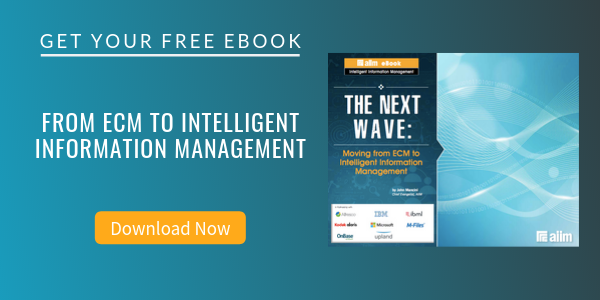
4 Questions Every Professional Should Ask About Their CRM System
Enterprise Content Management (ECM) | CRM
Every organization wants to increase agility and productivity by extracting maximum value from its processes and content. Organizations need to bridge the silos created by disparate lead applications to seamlessly pull structured and unstructured information together and present the whole story to the customer relationship management (CRM) users who need it. Easy access to documents and content is a key requirement in fully leveraging a CRM system. 95% of CRM users want easy access to the latest version of their files and documents, and 55% of CRM customers see “ease of use” as the most important feature.
Here are four questions every C-level executive and business professional should ask about their CRM system:
1. Why is an integrated approach to CRM content important?
Storing content within a transactional system (like a CRM system) is much more expensive than storing it in an ECM repository. Storing content within the CRM system also increases legal, regulatory, and audit costs. Consider these data points from a variety of AIIM surveys:
- On average, organizations store 54% of their business content within expensive and transactional line-of-business “lock-boxes.”
- 45% of organizations say that their ECM systems struggle or fail to adequately Integrate with core enterprise systems.
- 66% of organizations say their most significant content challenge is content in silos scattered across different applications and repositories
- 70% of organizations believe their line-of-business applications provide inadequate content functionality, but they use them anyway for managing content.
2. What are the implications of a lack of integration between ECM and CRM systems?
The creation of multiple and incompatible information silos within transactional systems makes it difficult to share customer information across business processes and almost impossible to get a complete understanding of the customer. Think about some of the common challenges that arise from a failure to integrate ECM and CRM systems:
- Multiple interfaces make it hard to find things and get context to make business decisions when needed.
- A lack of customer insights and understanding because correspondences, contracts and documentation aren't stored or accessed in a single application.
- Long search times and lack of content consistency and context leads to the need for additional overhead, duplication of efforts and communication errors.
The lack of integration between content capabilities and CRM systems is clearly a recipe for frustration that takes these forms:
- Incomplete or missing information
- Longer time to resolve customer inquiries
- Limited collaboration for sales teams on opportunities
- Critical customer documents not linked to information in the CRM system
- Missed up-sell and cross-sell opportunities
- Gaps between inconsistent and out-of-date information in multiple systems
- Inadequate governance capabilities in CRM system resulting in non-compliance and legal exposure
3. Who benefits from an integrated approach to CRM content?
To provide customer-centric products and services, an organization needs a holistic view of the customer’s interactions, including sales history, support requests, past and present disputes, and contract history. Here are some of the benefits of a strategic approach to managing the content that is tied to CRM processes to key executives in your organization:
- Sales professionals are typically on the road, and an ability to manage customer information on-the-go and on mobile devices is critical. If that content is going to be relevant, actionable and personal, it needs context from other core business applications.
- Marketing professionals gain a better understanding of what strategies work -- and which don’t. Best-in-class companies realize that marketing, sales and service processes accelerate and improve when campaign dossiers and customer files deliver complete and up-to-date collections of marketing assets, communication or field records.
- Better alignment across departments by havng the latest version of all critical documents surface within your CRM system.
- Finance, Customer Service, and Legal can access the correct version of contracts, correspondence, and product and shipping information, expediting the processing and fulfilment of customer orders.
- Shortened Sales cycles through one-stop access to contracts, correspondence, and customer information.
- Reduced Legal and Compliance risk by managing personally identifiable information in a content system that was designed for this purpose.
4. What are the benefits of an integrated content approach your CRM system?
- Provides 360-degree view of customer information
- Increased knowledge worker productivity, satisfaction, and effectiveness
- Simplified cross-departmental collaboration
- Provides single source of truth for customer information
- Controls unstructured content through information governance
- Standardizes templates, policies for customer communication
Conclusion
CRM systems are critical to effective customer relationships. But CRM systems with an ad hoc approach to managing customer information are suboptimal. Customer data only provides part of the picture of a customer relationship; the richness and context of the relationship is usually revealed in the unstructured information that is related to the customer. And unless that information is accurate and easily available to all of the people involved in the relationship -- from marketing to sales to finance to customer service and everything in between -- there is a strong likelihood of costly process failures and dashed customer expectations.
About John Mancini
John Mancini is the President of Content Results, LLC and the Past President of AIIM. He is a well-known author, speaker, and advisor on information management, digital transformation and intelligent automation. John is a frequent keynote speaker and author of more than 30 eBooks on a variety of topics. He can be found on Twitter, LinkedIn and Facebook as jmancini77. Recent keynote topics include: The Stairway to Digital Transformation Navigating Disruptive Waters — 4 Things You Need to Know to Build Your Digital Transformation Strategy Getting Ahead of the Digital Transformation Curve Viewing Information Management Through a New Lens Digital Disruption: 6 Strategies to Avoid Being “Blockbustered” Specialties: Keynote speaker and writer on AI, RPA, intelligent Information Management, Intelligent Automation and Digital Transformation. Consensus-building with Boards to create strategic focus, action, and accountability. Extensive public speaking and public relations work Conversant and experienced in major technology issues and trends. Expert on inbound and content marketing, particularly in an association environment and on the Hubspot platform. John is a Phi Beta Kappa graduate of the College of William and Mary, and holds an M.A. in Public Policy from the Woodrow Wilson School at Princeton University.



